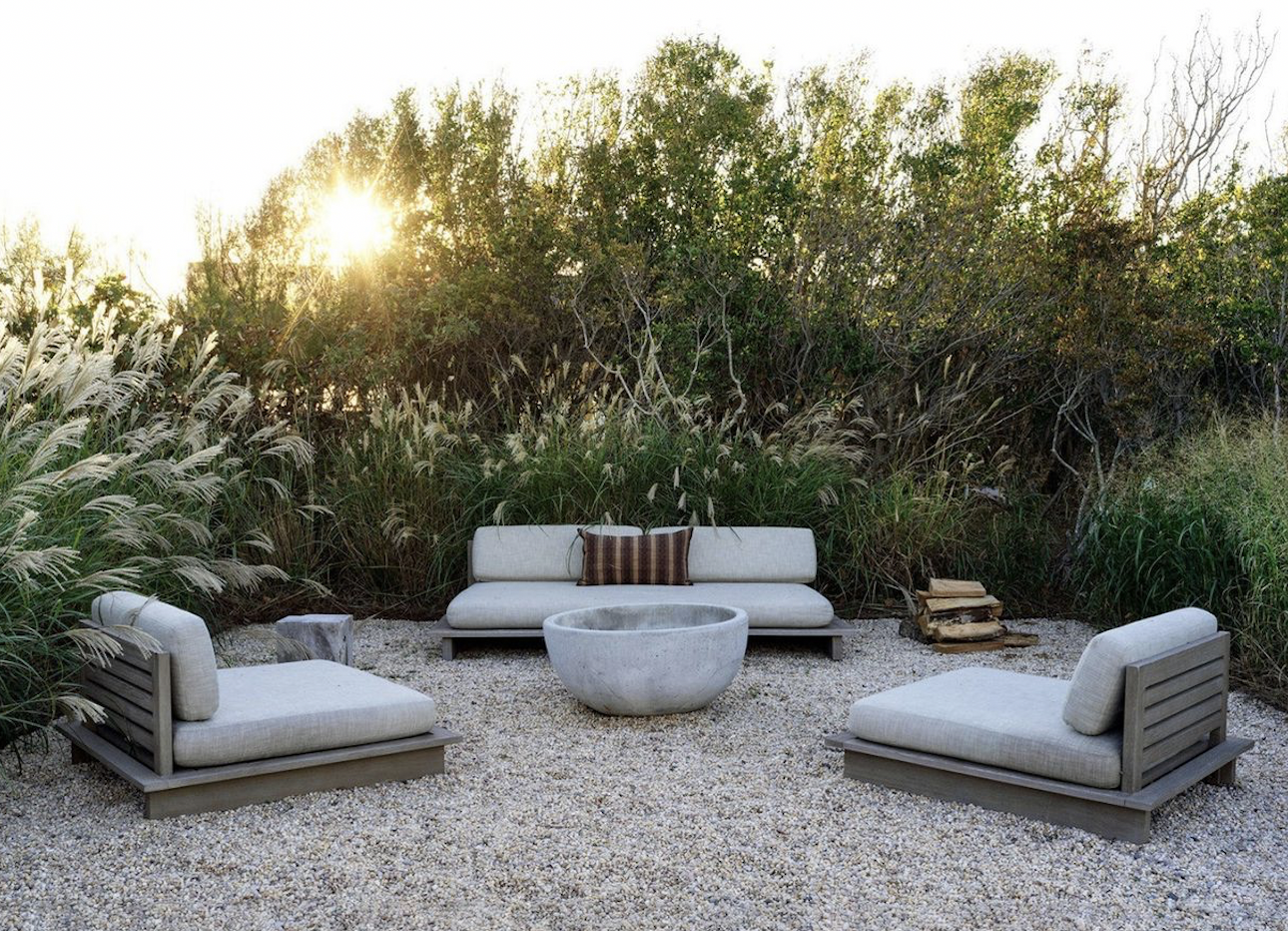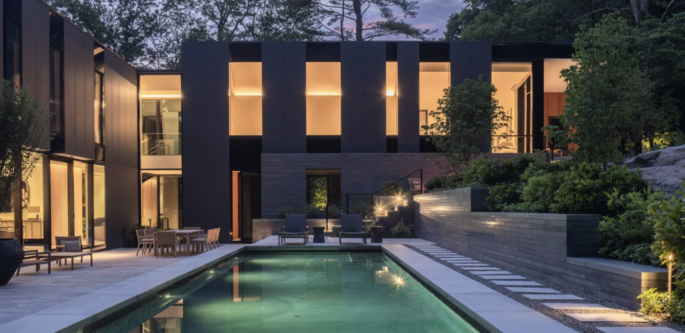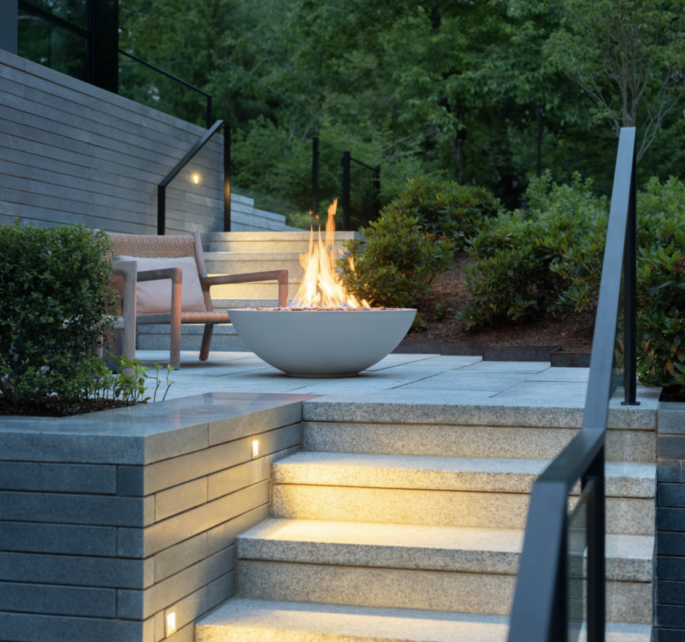The past year has shown us perhaps more than ever how vital outdoor spaces are. Living, dining, holiday retreat…your outdoor plot can do it all. Whether you have a tiny terrace or acres to play with, our ideas will help you max out your outdoors and create your own soothing oasis. Learn the tricks to create a country garden without a yard? How the right lighting can transform your outdoors in to a luxury resort. Start nurturing a restorative plot that will soothe anxiety.
Learn how garden lighting should be layered, your plantings should soothe you and the décor should be as thoughtfully considered as your living room.
It’s important to think of an outdoor space with the same logic as an indoor one. But as soon as homeowners step outside their back doors, sometimes even the most discriminating lose their well-honed sense of aesthetics. Oh, and don’t assume that just because your home doesn’t have a garden, you can’t create one. Some of the best designs arise out of constraints and a good designer will be able to see even the most unpromising roof space, or alleyway with new eyes.
Here we discuss tips on the patio, deck, and garden wrongs with strategies that will have your neighbours asking if you’ll tackle their garden next.
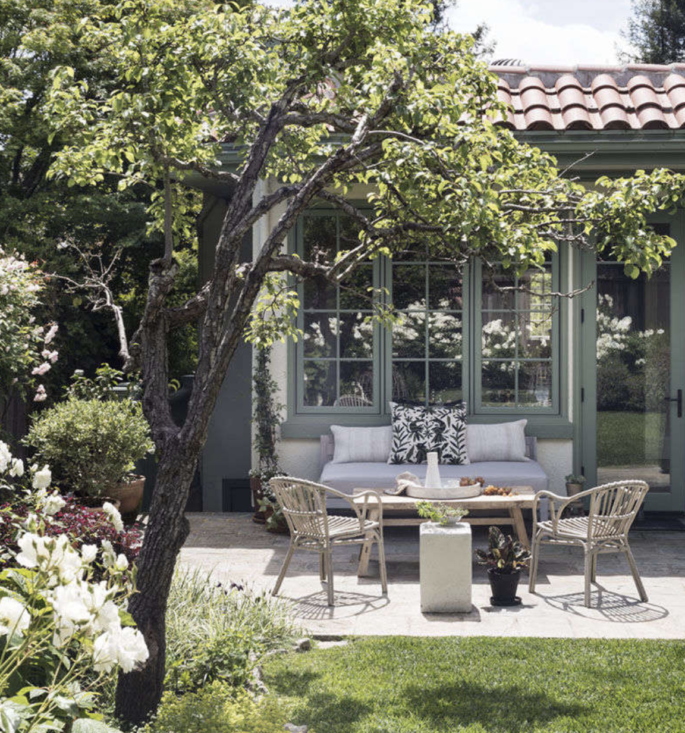
Living room, restaurant, holiday retreat…your outdoor plot can do it all. Image via Gardenista.com
The New Trend in Home Gardens –
Landscaping to Calm Anxiety
For centuries, Japanese monks have reaped the benefits of contemplative plots. Now clients are asking landscape architects for gardens that, rather than relying on showy flowers, create a sanctuary that soothes sensually—via sound, scent, and movement, among other factors. Here’s how they do it.
Whispering grasses, the plashing of a fountain, the hypnotizing crunch of gravel underfoot create a meditative experience. Now a housebound worldwide population is seeking distraction and escape is establishing home gardens that evoke some of that Eastern horticulture wisdom.
What sets apart an oasis of calm from a typical backyard? A more immersive experience.
“Your attention is occupied by sights, sounds, smells, textures—and the more multisensory you make something, the less likely you are to think about work,” said Giulia Poerio, Ph.D., a psychology researcher who focuses on emotion and well-being at England’s University of Essex. Here’s how to build your botanical chill pill. Read more, ‘Want A Gorgeous Garden Fast? Here’s What To Plant.’
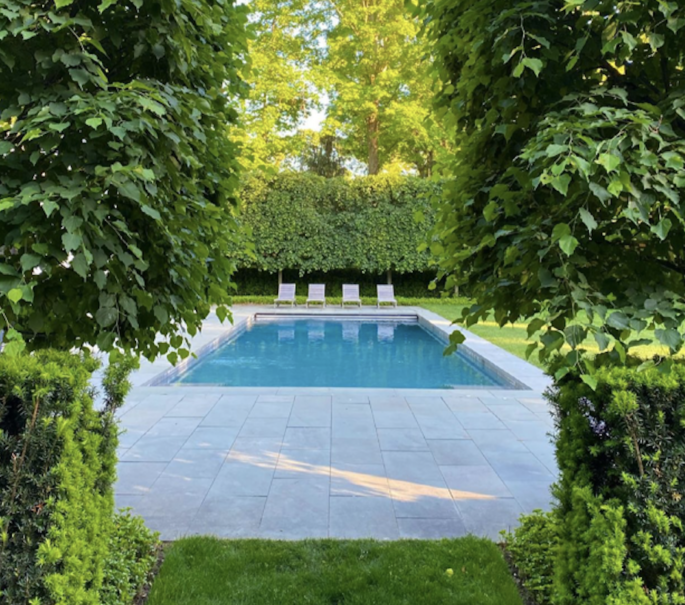
When a view is partially screened, you establish a sense of perspective and discovery. A peek into a serene setting by Kathryn Herman Design.
Turn Down the Colours
Loud hues don’t cultivate serenity. “Reds, oranges and yellows are hot colours that stir passion,” said New York landscape architect Edmund Hollander, who recommends mining the other end of the spectrum for tranquility. “The gradation of blues into greens is almost the colours of a stream, with whites and creams representing movement.” Read more, ‘Key Outdoor Trends To Make The Most of Your Garden All Year.’
Lead the Eye
Avoid wide open spaces. A journey in a garden – however small – is an important design device, leading you on and creating a sense of discovery as you progress. When a view is partially screened, you establish a sense of perspective and mystery. Curved paths work well, as does tall planting and trails that wind through the landscape. You can introduce structure with tall hedging or trees that obscure or veil the space beyond, or direct you to the final destination. Think about softening hard edges—fencing, walls, sheds, staircases—with greenery. It’s about the concept of journey. You can’t come out of the house and be in that space. You have to go somewhere, even if it’s only three steps. Read more, ‘How To Improve Your Outdoor Space.’
Feed on Grasses
Grasses set a mood in a garden, like candlelight at a dinner party. Plant grasses in masses to create a soft, blurred background for other plants. If you’re sitting in a chair next to taller plants, you feel protected. It’s a romantic, forgiving look, not unlike the effect you get from rubbing Vaseline on a lens before snapping a photo.
The soft rustle of grass adds soothing sounds to the garden, similar to a fountain.

Make your garden an immersive experience. Image via RoyalBotania.com
Speaking of Fountains…
Nothing creates a greater sense of peace than the sound of water. A fountain is a celebration. They bring so much pleasure and life to a landscape. That lovely burble. A jet of water is hypnotic to watch as it catches sunlight and throws a fine, bright mist into the air. One of the loveliest features of a fountain is the sound of running water. Site a fountain in a quiet spot to match the style of your garden, (away from traffic) where you will be able to hear the burbling. Or place a fountain next to a walkway so you can hear the sound of running water every time you walk past. Read more, ‘Making a Modern Garden.’
Under the Sun
As much as we love the sunshine, a bit of shade is always welcome, enabling you to enjoy the heat without burning up in the sun’s rays. Options range from plant-covered pergolas to awnings and permanent pavillions. Whichever you choose, all will help zone your space.
Opt for Organic Furniture
Reject cold metals and synthetic materials. Rattan, wood and cane let you underline the earthy theme of the quiet garden. Chicago interior designer Amanda Norcross, co-owner of Norcross + Scott, relies on open-weave materials like wicker that can offset the rigidity of decking and stone. Woven furniture also brings “this subconscious connection to the maker,” she said. “It has a life to it.” Read more, ‘6 Outdoor Furniture Trends of 2020- For Any Budget.’

Sustainable, organic outdoor furniture is the way forward and can look good too. Soul-Cycle co-founder Julie Rice’s Light-Filled Montauk Retreat features a pair of Luteca’s woven Tule chairs and ottomans, plus a custom outdoor sectional and chair covered in Janus et Cie fabric. A woven palm umbrella was sourced from Europe. Photo: Chris Mottalini for ArchitecturalDigest.com
Take Art to Heart
Some hard lines, especially those of sculptures, complement quietude. Contrasting the natural forms found in gardens with controlled elements of structure is important. He’s fond of rust-coloured totem-like pieces, sometimes placed on a coffee table or along a path. Creating a juxtaposing line creates an unexpected dimensional layer.
Hear Every Step
Humble gravel has become the most hypnotizing landscape material for paths and patios of the past decade. Because it looks good, feels good underfoot, benefits the environment, saves money and adds a great textural quality. It is a softer way to hardscape. The quiet scrunch underfoot adds to the meditative effect.
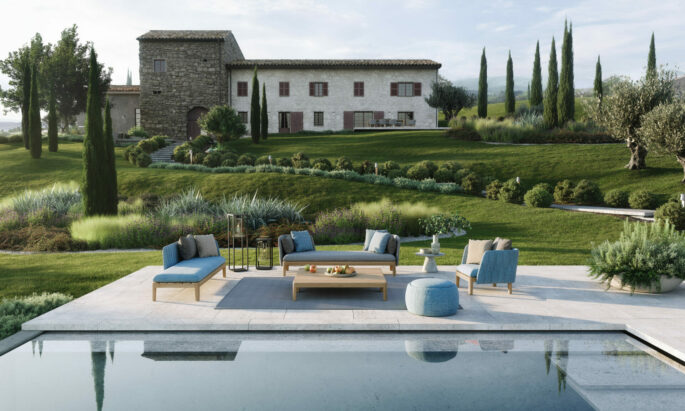
Loud hues don’t cultivate serenity. Tone down the colours. Rather than relying on showy flowers, create a sanctuary that soothes sensually—via sound, scent, and movement, among other factors. Image via RoyalBotania.com
Outdoor Lighting Tips to Make Your Yard Look Like a Luxury Resort
Many of us upgraded our outdoor spaces over the pandemic: sectional sofas, fire pits, the works. But few of us invested in well-designed and executed lighting. Designers advise that we should follow the same concept for illumination outdoors as we do for lighting indoors: careful layering. Think about the direction, volume and intensity of light. Think of your garden as another room and apply as much creativity as you would to any other space in your home by getting the balance right between darkness and layers of light. Set the scene with a decorative wall lights that suits the style of your home
The best way to make your outdoor space elegantly enjoyable after dark is a lighting scheme as layered as your living room’s. Here’s how.
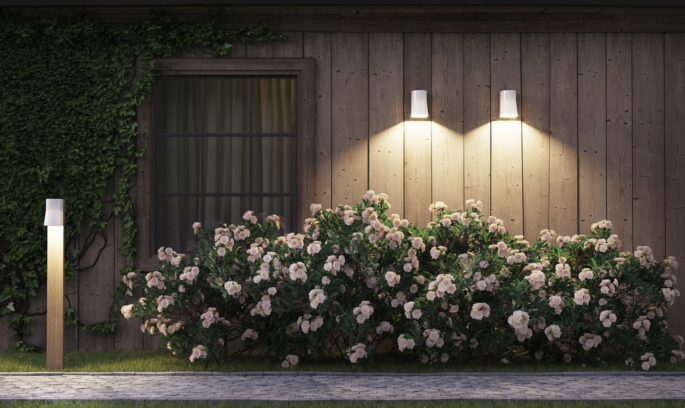
It’s important to consider both the function and the aesthetic of your outdoor lighting. Image via RoyalBotania.com
Last year, those of us fortunate enough to have a backyard to call our own tended our gardens and zhushed our patios with new furniture, maybe even springing for an outdoor rug.
When it came to exterior lighting, however, most people aimed no higher than a swag of Edison-bulb string lights and a flickering hurricane candle.
Outdoor spaces sometimes get overlooked after the sun goes down. This season, however, as we prepare to host en plein air again, why not tackle outdoor lighting—especially if you’ve upgraded everything else? Beyond a wish to enjoy their private plot at night, homeowners light landscapes so that when you’re inside the house you can see the garden and not just a black hole. Read more, ‘How To Create An Outdoor Room.’
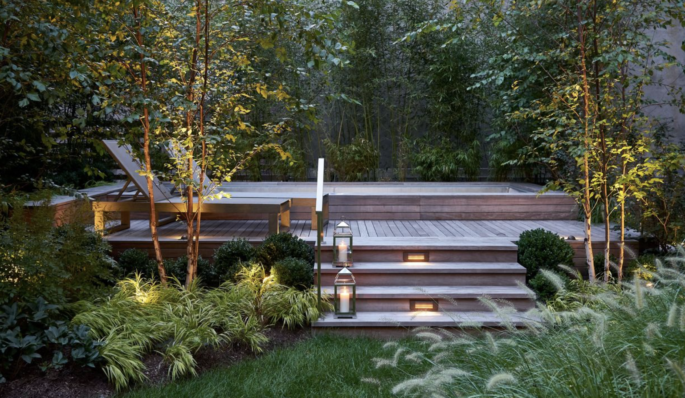
A series of layers emphasize depth and create a sense of discovery as you move into the space, said New York landscape architect Edmund Hollander of this tucked-away section of a local terrace. Photo by Joshua McHugh
LAYERED LIGHTING
The best way to banish murky shadows is to borrow the sort of layered lighting scheme found in professionally designed living rooms. In simplest terms, you want three tiers. Start with the highest level, via lofty lanterns or up-lighting that draws eyes skyward or even chandeliers (yes, weatherproof versions exist; see “Worth Wiring”). Next fill in the midrange with sconces, illuminated plants or sculptures, and tabletop portable lanterns. And don’t forget low-level illumination—that is path, under step and under seat lighting.When designing a garden, keep it simple: Two or three layers are enough.
The cumulative effect should be subtle, not stark, “that feeling of fireflies on a summer night, that sense of discovery,” as San Francisco designer Ken Fulk put it. “The default has previously been an overly lit space.”
‘We can be impactful without being garish or feeling like we’re in Las Vegas.’
Today’s LED fixtures suck as little as 3 watts as opposed to the 35 watts that incandescents fed on. That means you can use low-voltage wiring, a small wire that can be buried under just 15cms of soil. You can install [that] after a garden is built, and it would not hurt you if you touched those wires. We recommend hiring a professional electrician or landscape firm to at least install your main transformer.
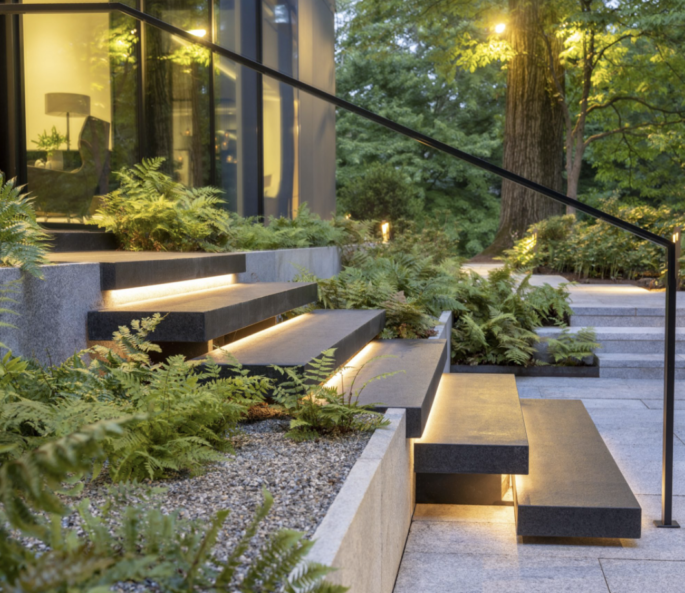
Lights on stairs are an effective and clever way to add sophistication to any garden. Photo: Kathryn Herman Design
ALTERNATIVE LIGHTING SOLUTIONS
Don’t wish to deal with running any kind of electrical wiring? You can easily find options that plug into an outdoor socket but are far more aesthetically ambitious than string lights. Examples include articulating floor lamps and hanging lamps.
Growing Roses for Beginners: The Secrets to Success
in the Garden
Have you been put off by roses because of their reputation for fussiness? Turns out that where roses are concerned, as with much of life, location matters most. That’s the key tip for inexperienced growers who come across a variety and fall in love.
“You have to really make sure that the rose is going to be suitable for where you live,” said Peter Schneider, editor of the annual Combined Rose List, an international reference guide. Visit a neighbour’s place to see what does in your location. Alternatively, you can find relevant information on a rose’s label, or in its catalogue or online description. Check that the rose is suitable for your zone. Right plant, right place.’Read more, ‘Your First Garden: How To Start A Garden For Practically Nothing.’

Yellow roses overwhelm Melissa’s country house. Photo: Abbie Melle
WHEN IS THE BEST TIME TO PLANT ROSES:
Spring and Autumn. Spring is a great time to plant because the temperatures are just right for root production and stem growth. Spring is also the time that nursery inventories are highest. Container-grown, or potted, roses can be planted throughout the growing season, whenever there isn’t frost, with special attention needed if you are planting in the Summer heat. Autumn is the preferred time to plant roses because the root system will have time to develop with no pressure to support new growth until the spring. The result is a plant that roars into growth in the spring.
ARE THERE ANY ROSES THAT REQUIRE LESS THAN 6 HOURS OF SUN A DAY?
In general, the fewer petals the rose has, the better it will do with more shade. Many species roses—native roses that haven’t been hybridized by man—bloom only once and bloom in the springtime.
There are a few roses that do well in part shade. However, for the intensity of the fragrance and bloom production, more light is required.
FOR URBANITES, CAN YOU GROW A POTTED ROSE ON A BALCONY?
I think growing roses on a balcony is completely doable and makes sense. The problem is figuring out what to do for the winter. If you have the wall of your building, not glass, but some sort of solid wall, which you could push the plant up against and then cover it all in burlap, and then maybe insulate some way even beyond that… You could cut it back and take it out of the pot and just put it in the refrigerator for the winter and let it have a dormant season.
But if it doesn’t survive winter, you can always just get another one and try again.
ARE THERE SPECIFIC ROSES THAT ARE GREAT FOR RE-BLOOMING?
Among repeat bloomers, the fewer petals the rose has the quicker it will re-bloom. It takes more energy for a plant to produce more petals.
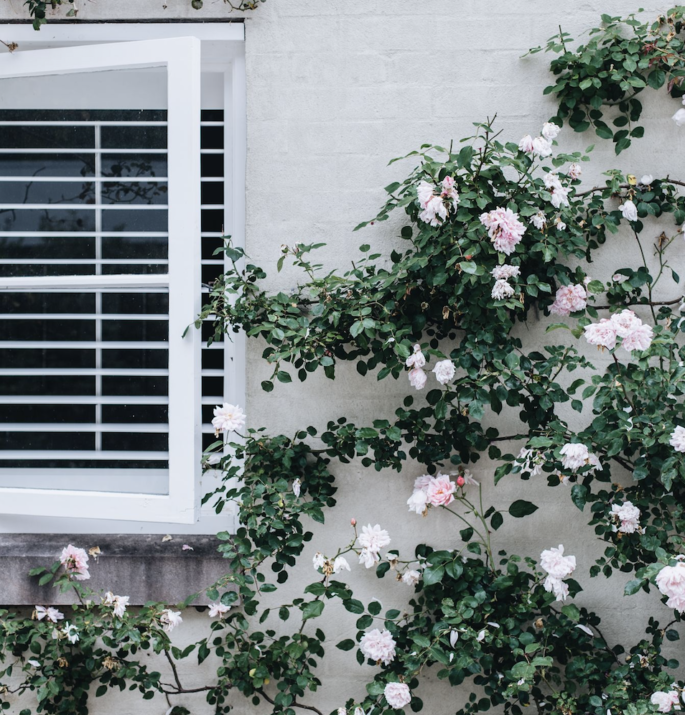
Climbing roses blooming perfectly last summer at Melissa’s Country House. Photo: Abbie Melle
How to Grow a Country Garden Without a Yard
Do you dream of a cutting garden but lack a plot in which to plant it? No problem. You can group together pots of flowering plants to create a profusion that convincingly makes a garden of even the most barren slab of cement. In fact, a container garden offers many advantages over planting in a real patch of earth. Read more, ‘Designing A Garden? You’ll Need a Plan.’
There is much to recommend container gardens. Containers are transformative ingredients. For turning a lifeless balcony, pavement or stairs into cottage gardens they are unparalleled. Fill pots with a few bright flowering plants such as tulips or geraniums, or floxgloves and iris, and and, you look like a gardening genius and your house will be transformed into a fairytale patch. Of course there are a few details to consider. It’s not simply a matter of getting any old pots or flowers. As with all home improvements, decisions must be made and certain materials and techniques are better than others.
Fill flower pots with several species, then set the containers side by side to embody the country house garden look …romantic, abundant and floriferous. It challenges the notion that vibrant, pollinator-friendly flower gardens require a country estate.

The city is a garden- so grow every nook and cranny. Image via Bacsac.com
City balconies and rooftops can be home to decidedly un-urban styles of the garden via container gardening, a method that offers some unanticipated advantages. Container gardeners use pots to play with height in ways not possible working in the ground.

A galvanized metal container with Erigeron karvinskianus (Mexican daisy) and Dianthus barbatus ‘Green Trick’ makes an instant garden. Photo: Gardenista.com
Jessica Smith, a floral designer, and gardener in Bath, England, created her doorstep cutting garden with containers during the 2020 lockdown. She had originally grown the seedlings on windowsills in a bid to supply her own wedding flowers (the ceremony was scuttled by the pandemic).
“Growing in containers meant that I could place my plants very closely together for an abundant and wild look with no gaps,” she said. This would be trickier in a traditional flower border, she added. “Plants need space for their roots and can’t compete well for water and nutrients. But in containers, each plant can be watered and fed individually and placed for maximum impact without [compromising] their needs.” Ms. Smith was able to nurture water-needy climbing roses alongside drought-tolerant cosmos, for example. Containers also let you position plants requiring different soil types—acidic versus alkaline, loamy versus sandy—beside each other.
“It is a liberating way of planting.”
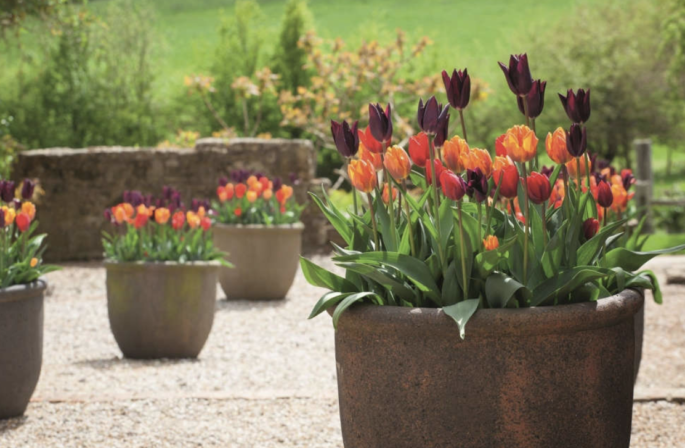
Tulips in large containers create a beautiful colourful patch. Photo: Gardenista.com
Container gardeners use planters to play with height in ways not possible when you’re planting in the ground.
For example, you can elevate smaller, lower-growing flowers such as calendula, also known as pot marigold, and place them anywhere in a display, said Ms. Smith. You can fashion improbable plant scapes using different-sized pots; containers raised on bricks concealed by pots in front; and teepees made of willow or bamboo for climbers such as sweet peas.
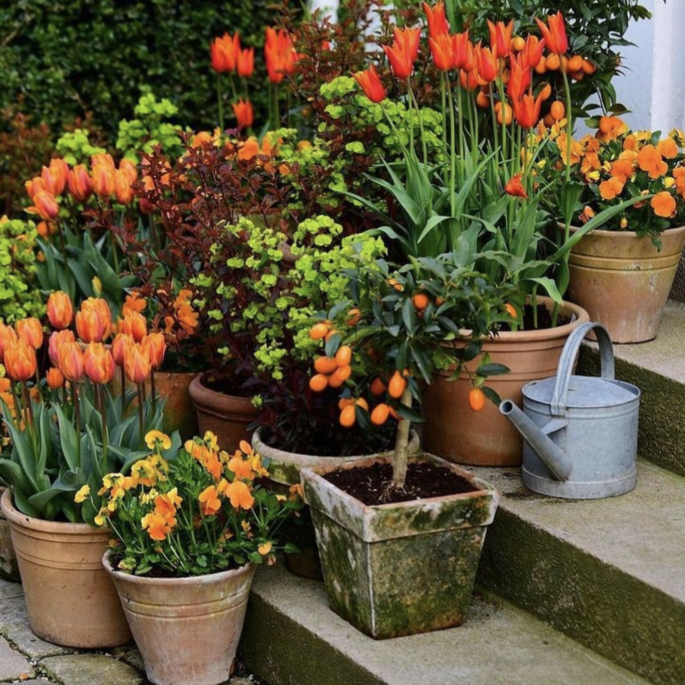
Danish celebrity gardener Claus Dalby, (Scandanavia’s Martha Stewart), is famed for his container gardens, recently announcing to his 310K followers on Instagram he signed a book deal on the subject with an American publisher. Image via @clausdalby
Most plants, including hydrangeas and rhododendrons, can grow in a pot, but if flowers for vases is your goal, focus on cosmos, dahlias and other “cut-and-come-again” flowers that proliferate after cutting. Ms. Smith harvested her sweet peas in the morning and returned in the evening to find a flurry of new blossoms ready for picking. “I never felt afraid to cut flowers as I knew it did them good and would ensure continual flowers all summer long.” Roses, too, are pottable and benefit from frequent cutting.
One challenge with growing container flowers is that they typically need to be fed and watered often because they aren’t insulated in the ground. And maintaining a potted garden throughout the year requires ingenuity. During the off-season, Mr. Parkinson lifts his dahlia tubers, storing them in shoeboxes indoors in a cool, dry space. Roses can remain in place but need frost protection. He typically treats tulips—less likely to repeat-flower successfully—as annuals, selecting new bulbs to plant each fall, a delightful chore.
Another advantage of a container garden? Its portability. Ms. Smith and her fiancé recently packed up her potted plants and drove them to a new house in Bath. The garden is already blooming.

Zinc Rectangle Planters by Domai sit pretty in a garden patio. Photo: Domani.com
*This is an excerpt from an original WSJ story

